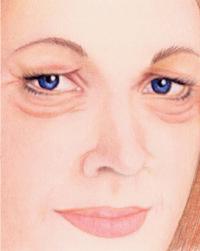BRA Day is an initiative designed to promote education, awareness and access for women who may wish to consider post-mastectomy breast reconstruction.
Blepharoplasty (Eyelid Lift)
Some people have eyelid surgery to correct problems that are a result of aging, while others have inherited traits such as bags under their eyes that cause them to seek treatment at a younger age.
Upper eyelid and eyebrows
If the upper eyelid condition is accompanied by sagging of the eyebrows, then a forehead (brow) lift may be recommended.
If surgery is required to correct the upper eyelid, the incision will be hidden within the natural fold of the upper eyelid and it is through this incision that excess skin and fat are removed.
Because the incision follows the natural contour of the upper eyelid, it will be well camouflaged when it has healed. Often, a small amount of fat from the upper eyelid is either removed or repositioned to improve the upper lid contour.
Crow’s feet and circles
Smoothing of crow’s feet may require toxin injection, chemical peeling, or laser resurfacing procedures. Circles beneath the eyes caused by dark pigmentation may be treated with a bleaching solution or chemical peel. Your plastic surgeon will provide the information required to make a decision.
Hollowing
Hollowing around the bony orbit below the eye can be addressed with fat grafting, filler injection or a mid-facelift. Talk to your plastic surgeon about the best option for you.
Lower lid
Your age and the extent of the fatty deposits you have will determine which approach to lower lid surgery is preferred.
There are two approaches – one which uses an external incision; the other is performed from inside the lower lid.
For lower lid surgery the incision is usually hidden below the lower lashes. Through this incision, excess skin, muscle and fat are removed. Fat may also be redistributed to improve puffiness or bulges.
Other adjustments such as canthopexy (eyelid tightening) may be done to correct special problems such as muscle laxity.
You and your plastic surgeon may decide that the best approach for removing excess fat is a technique that needs no external incision.
This procedure is called trans-conjunctival lower blepharoplasty. While it is a good approach for younger patients, it cannot be used to remove excess skin so a laser may be used in conjunction with this method to tighten the skin under the eyes.
Recovery and possible risks
High blood pressure, thyroid problems or diabetes are some of the conditions that can increase the risks during eyelid surgery. Your plastic surgeon will ask if you have allergies, or if you have been told that you have “dry eye” or any other eye problems.
After your surgery, you may have a feeling of dryness or irritation in the eye. This may require treatment. There is also a chance of a temporary reduction in eyelid sensation or impaired eyelid function. Impaired lid function may be treated with additional surgery.
Mild swelling persists for several weeks in some cases while others see swelling resolve in just seven days.



